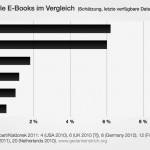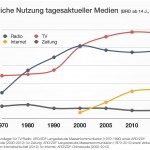Lektürehinweis: »Losing the Signal« (BlackBerry)
Jan-Felix Schrape | 25. Mai 2015Das Unternehmen BlackBerry, das bis 2013 unter dem Namen Research in Motion firmierte, gehörte 2007 zu den dominierenden Anbietern im Smartphone-Bereich. Heute spielt Blackberry hingegen auf dem Feld der Mobile Devices allenfalls noch eine randständige Rolle. Wie es dazu kam und was die damals für alle Beteiligten überraschende Markteinführung von Apples iPhone damit zu tun hatte, beschreibt das frisch erschienene Buch »Losing the Signal« (McNish/Silcoff) auf unterhaltsame Weise (durchaus tauglich für die entspannte Lektüre an einem lauen Sommerabend).
Als Hauptgrund für den schnellen Abstieg von RIM/BlackBerry stellen die Autoren des Buches eine folgenreiche Fehleinschätzung des Managements nach der erstmaligen Vorstellung des iPhones Anfang 2007 heraus:
»If the iPhone gained traction, RIM’s senior executives believed, it would be with consumers who cared more about YouTube and other Internet escapes than efficiency and security. RIM’s core business customers valued BlackBerry‘s secure and efficient communication systems. Offering mobile access to broader Internet content, says Mr. Conlee, ›was not a space where we parked our business‹.«
Dass überdies die äußere Form (das look and feel) für die Nutzer zwischenzeitlich ähnlich wichtig wie die Funktionen des jeweiligen Geräts geworden war, erkannten die Verantwortlichen nach dieser Erzählung ebenfalls zu spät – und als die Gefahr durch das iPhone und entsprechende Nachfolgeprodukte dann endlich erkannt worden war, handelte BlackBerry vollkommen übereilt (Exzerpt aus dem Buch bei WSJ):
»Verizon went searching for an antidote to viral iPhone sales in August and RIM, then the world’s largest smartphone maker, was its chosen supplier. […] Mr. Lazaridis’s [RIM] solution was Storm, a phone that was little more than a prototype in 2007. Like the iPhone, Storm featured a glass screen. Unlike Apple’s phone, it had a movable screen. Users could activate the phone’s digital keyboard by pressing the screen down […].
Verizon officials loved Storm […] and Mr. Lazaridis felt he couldn’t say no even though Verizon set a punishing deadline of launching Storm by the spring of 2008. The nine-month deadline came and went, and it wasn’t until 15 months later in November 2008 that RIM was able to start shipping Storm phones for the busy Christmas season. Internally, most of RIM’s engineers knew the company was shipping a flawed product. The browser was painfully slow, the clickable screen didn’t respond well in the corners and the device often froze and reset. Like most tech companies launching a glitchy product, RIM played for time. Verizon stoked sales with heavy subsidies, while RIM’s engineers raced to introduce software upgrades to eliminate Storm’s many bugs.
[…] Storm’s success was fleeting. […] Virtually every one of the 1 million Storm phones shipped in 2008 needed replacing […]. Many of the replacements were being returned as well.«
Das erste Mal in seiner Geschichte hatte RIM/BlackBerry mit dem Storm ein Produkt auf den Markt gebracht, das den eigenen Qualitätsstandards nicht entsprach und die Kunden im Alltag frustrierte. Der damit einhergehende Image-Schaden war kaum mehr zu reparieren, zumal das BlackBerry Storm aufgrund der aggressiven Verizon-Vermarktung auch noch das meistverkaufte Produkt seit Markteintritt für RIM war. Nach diesem für alle Marktteilnehmer sichtbaren Fehlschlag fand sich das Unternehmen augenscheinlich in einer kaum auflösbaren Unsicherheitssituation: »The Storm failure made it clear we were not the dominant smartphone company anymore. We’re grappling with who we are because we can’t be who we used to be anymore, which sucked…It’s not clear what the hell to do.« (Jim Balsillie , RIM z.n. WSJ)














